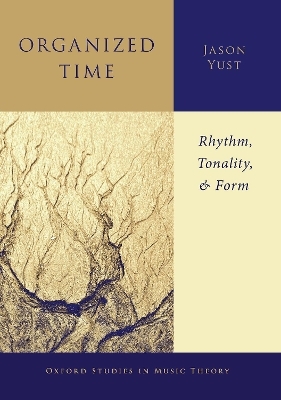
Organized Time
Oxford University Press Inc (Verlag)
978-0-19-754642-0 (ISBN)
Organized Time is the first attempt to unite theories of harmony, rhythm and meter, and form under a common idea of structured time. Building off of recent advances in music theory in essential subfields-rhythmic theory, tonal structure, and the theory of musical form--author Jason Yust demonstrates that tonal music exhibits similar hierarchical organization in each of these dimensions. Yust develops a network model for temporal structure with an application of mathematical graph theory, which leads ultimately to musical applications of a multi-dimensional polytope called the associahedron. A wealth of analytical examples includes not only the familiar tonal canon-J.S. Bach, Mozart, Schumann--but also lesser known masters of the musical Enlightenment such as C.P.E. and J.C. Bach, Boccherini, and Johann Gottlieb Graun.
Yust's approach has wide-ranging ramifications across music theory, enabling new approaches to musical closure, hypermeter, formal function, syncopation, and rhythmic dissonance, as well as historical observations about the development of sonata form and the innovations of Haydn and Beethoven. Making a forceful argument for the independence of musical modalities and for a multivalent approach to music analysis, Organized Time establishes the aesthetic importance of structural disjunction, the conflict of structure in different modalities, in numerous analytical contexts.
Jason Yust is Assistant Professor of Music Theory at Boston University. Born in St. Louis, Missouri, he received a BA in Music at Brown University and a PhD in Music Theory from the University of Washington. His research interests include mathematical theories of harmonic space; metrical, tonal, and formal structure in tonal music; and music perception and cognition.
Contents
Introduction
Time and Landscape
Dimension
Chapter 1: Rhythmic Hierarchy and the Network Model
1.1 Metric and Rhythmic Structures as Temporal Hierarchies
1.2 Rhythmic Classes and Transformations
1.3 Inferring Rhythmic Hierarchies
1.4 Metricality
Chapter 2: Tonal Structure
2.1 Melodic Structure
2.2 Backgrounds
2.3 Repetition
2.4 Keys
2.5 Tonal Models for Binary Forms
Chapter 3: Formal Structure
3.1 Elements of Form: Repetition, Contrast, Fragmentation
3.2 Small Baroque Forms
3.3 Expositions and the Secondary Theme
3.4 Interactions of Form and Tonal Structure
Chapter 4: Structural Networks and the Experience of Musical Time
4.1 Depth, Distance, and the Classification of Structural Shapes
4.2 A Phenomenology of Structure
4.3 Center, Skew, and Bias
4.4 Splitting and Disjunction
Chapter 5: Timespan Intervals
5.1 Large-Scale Rhythmic Design in Bach's F Minor Fugue
5.2 Classification of Timespan Intervals
5.3 Hypermetric Hemiola in a Bach Prelude
5.4 Transformations of Rhythmic Structures
Chapter 6: Hypermeter
6.1 Hypermeter in the Eye of the Beholder
6.2 Some Criteria for Hypermetric Analysis
6.3 Functions of Hypermetric Shift in Haydn's Symphonies
6.4 Indefinite Hypermeter and Hypermetric Reinterpretation
Chapter 7: Hypermeter, Form, and Closure
7.1 Hypermetric Placement in Cadential Syntax
7.2 Mozart's Afterbeat Melodic Ideas
7.3 Main Theme Endings in Haydn's Symphonies
7.4 Elided Cadences and Expositional Closure
7.5 Beethoven's Open Expositions
Chapter 8: Syncopation
8.1 Contrapuntal and Tonal versus Structural Syncopation
8.2 Contrapuntal Syncopation and Metrical Dissonance
8.3 Hypermetric Syncopation and Contrapuntal Displacement
8.4 Rhythmic Process as Formal Process in Beethoven
Chapter 9: Counterpoint
9.1 Rhythmic Counterpoint
9.2 Brahms's Use of Rhythmic Irregularity and Rhythmic Counterpoint
9.3 Counterpoint of Tonal Structures
9.4 Formal Counterpoint
Chapter 10: Harmony Simplified
10.1 Harmonic Syntax and Structure
10.2 Voice Leading on the Tonnetz
10.3 Enharmonicism
Chapter 11: Reforming Formal Analysis
11.1 Tonal Disjunction and the Phrase
11.2 Ritornello Form in the Eighteenth-Century Symphony
11.3 Form(s) and Recipes
11.4 Outside the Frame
Chapter 12: Tonal-Formal Disjunction
12.1 High-Level Tonal-Formal Disjunction in Sonata Form
12.2 Alternate Subordinate Keys
12.3 Disjunction in the Exposition: Modulating Subordinate Themes
12.4 Off-Tonic Recapitulations
Chapter 13: Graph Theory for Temporal Structure
13.1 Planarity and Cycles
13.2 Direction and Confluence
13.3 Chords and Holes
13.4 Reduction Trees, Event Trees, and Spanning Trees over MOPs
13.5 Spanning Trees and the Cycle/Edge-Cut Algebras
Chapter 14: A Geometry of Temporal Structure
14.1 Associahedra
14.2 Higher-Dimensional Associahedra and their Facets
14.3 Evenness
Epilogue
| Erscheinungsdatum | 05.10.2020 |
|---|---|
| Reihe/Serie | Oxford Studies in Music Theory |
| Zusatzinfo | 543 musical examples |
| Verlagsort | New York |
| Sprache | englisch |
| Maße | 178 x 251 mm |
| Gewicht | 771 g |
| Themenwelt | Kunst / Musik / Theater ► Musik ► Musiktheorie / Musiklehre |
| ISBN-10 | 0-19-754642-0 / 0197546420 |
| ISBN-13 | 978-0-19-754642-0 / 9780197546420 |
| Zustand | Neuware |
| Haben Sie eine Frage zum Produkt? |
aus dem Bereich


